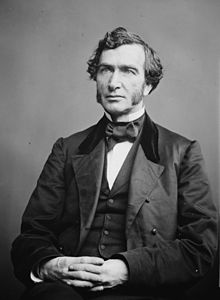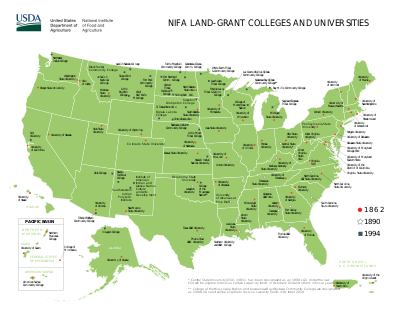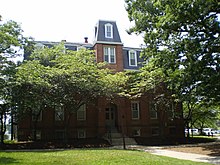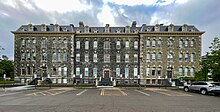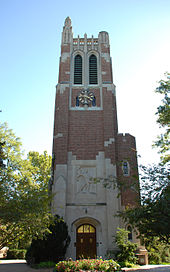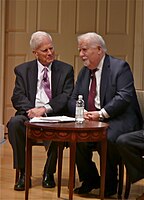
The Hatch Act of 1887 gave federal funds, initially $15,000 each, to state land-grant colleges in order to create a series of agricultural experiment stations, as well as pass along new information, especially in the areas of soil minerals and plant growth. The bill was named for Congressman William Hatch, who chaired the House Committee of Agriculture at the time the bill was introduced. State agricultural stations created under this act were usually connected with those land-grant state colleges and universities founded under the Morrill Act of 1862, with few exceptions.
Separate but equal was a legal doctrine in United States constitutional law, according to which racial segregation did not necessarily violate the Fourteenth Amendment to the United States Constitution, which nominally guaranteed "equal protection" under the law to all people. Under the doctrine, as long as the facilities provided to each race were equal, state and local governments could require that services, facilities, public accommodations, housing, medical care, education, employment, and transportation be segregated by race, which was already the case throughout the states of the former Confederacy. The phrase was derived from a Louisiana law of 1890, although the law actually used the phrase "equal but separate".

The National Sea Grant College Program is a program of the National Oceanic and Atmospheric Administration (NOAA) within the U.S. Department of Commerce. It is a national network of 34 university-based Sea Grant programs involved in scientific research, education, training, and extension projects geared toward the conservation and practical use of the coasts, Great Lakes, and other marine areas. The program is administered by the National Oceanic and Atmospheric Administration (NOAA) with the national office located in Silver Spring, Maryland. There are Sea Grant programs located in every coastal and Great Lakes state as well as in Puerto Rico and Guam.

A land-grant university is an institution of higher education in the United States designated by a state to receive the benefits of the Morrill Acts of 1862 and 1890, or a beneficiary under the Equity in Educational Land-Grant Status Act of 1994. There are 57 institutions which fall under the 1862 Act, 19 under the 1890 Act, and 35 under the 1994 Act.
Historically black colleges and universities (HBCUs) are institutions of higher education in the United States that were established before the Civil Rights Act of 1964 with the intention of primarily serving African Americans. Most of these institutions were founded during the Reconstruction era after the Civil War and are concentrated in the Southern United States. They were primarily founded by Protestant religious groups, until the Second Morill Act of 1890 required educationally segregated states to provide African American, public higher-education schools in order to receive the Act's benefits.

Justin Smith Morrill was an American politician and entrepreneur who represented Vermont in the United States House of Representatives (1855–1867) and United States Senate (1867–1898). He is most widely remembered for the Morrill Land-Grant Acts that provided federal funding for establishing many of the United States' public colleges and universities. Originally a Whig, after that party became defunct Morrill was one of the founders of the Republican Party.
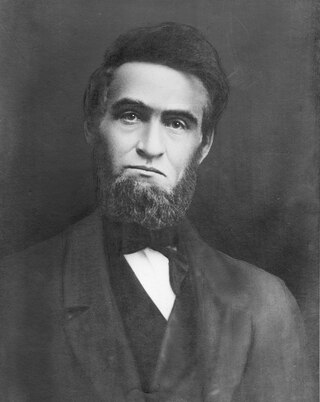
Jonathan Baldwin Turner was an American classical scholar, an ordained minister, a professor, a campaigner for the abolition of slavery, and political activist. He also campaigned in favor of land grant universities. In 1835, Turner married Rhodolphia Kibbe and they had seven children.

Texas A&M AgriLife Extension Service was formally established in 1915 after the 1914 passing of the Smith-Lever Act and in conjunction with Texas A&M University. Originally named Texas Agricultural Extension Service, then later Texas Cooperative Extension, the name Texas AgriLife Extension Service was adopted on January 1, 2008. A&M was added to the agency name on September 1, 2012 as a result of a Texas A&M University System change to strengthen the association with Texas A&M. The primary mission of AgriLife Extension is to provide educational outreach programs and services to the citizens of Texas. In conjunction with Texas A&M AgriLife Research, the Extension faculty members conduct research and bring practical applications of those research findings to the people of Texas.
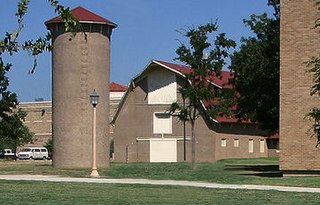
Agricultural education is the systematic and organized teaching, instruction and training available to students, farmers or individuals interested in the science, business and technology of agriculture as well as the management of land, environment and natural resources.
An agricultural experiment station (AES) or agricultural research station (ARS) is a scientific research center that investigates difficulties and potential improvements to food production and agribusiness. Experiment station scientists work with farmers, ranchers, suppliers, processors, and others involved in food production and agriculture.
The history of Michigan State University dates back to 1855, when the Michigan Legislature established the Agricultural College of the State of Michigan under the encouragement of the Michigan State Agricultural Society and the Michigan Farmer, the state's leading agricultural periodical. As the first agricultural college in the United States, the school served as a model for other institutions of its kind established in the period, to give an instance, the Agricultural College of Pennsylvania.

The Association of American Universities (AAU) is an organization of American research universities devoted to maintaining a strong system of academic research and education. Founded in 1900, it consists of 71 public and private universities in the United States as well as two universities in Canada. AAU membership is by invitation only and requires an affirmative vote of three-quarters of current members.

The New Jersey Agricultural Experiment Station is an entity currently operated by Rutgers, The State University of New Jersey in conjunction with the State of New Jersey in the university's role as the state's sole land-grant university. Today, it conducts research in agriculture, horticulture and turf grass science, and through the Rutgers Cooperative Extension aids New Jersey farmers, landscapers, and residents in each of the state's twenty-one counties.
The New York State College of Forestry, the first professional school of forestry in North America, opened its doors at Cornell University, in Ithaca, New York, in the autumn of 1898., It was advocated for by Governor Frank S. Black, but after just a few years of operation, it was defunded in 1903, by Governor Benjamin B. Odell in response to public outcry over the College's controversial forestry practices in the Adirondacks.

New Jersey Hall is a historic education building located on the campus of Rutgers University in New Brunswick, New Jersey. Built in 1889 under the leadership of President Merrill Edward Gates, it housed the Agricultural Experiment Station. It was added to the National Register of Historic Places on February 24, 1975, for its significance in agriculture and education.
The history of North Carolina Agricultural and Technical State University, the first land grant college for people of color in the state of North Carolina, can be traced back to 1890, when the United States Congress enacted the Second Morrill Act which mandated that states provide separate colleges for the colored race. The "Agricultural and Mechanical College for the Colored Race" was established On March 9, 1891 by an act of the General Assembly of North Carolina and began in Raleigh, North Carolina as an annex to Shaw University. The college made a permanent home in Greensboro with the help of monetary and land donation by local citizens. The college granted admission to both men and women from 1893 to 1901, when the board of trustees voted to restrict admission to males only. This policy would remain until 1928, when female students were once again allowed to be admitted.

The Cooperative State Research, Education, and Extension Service (CSREES) was an extension agency within the U.S. Department of Agriculture (USDA), part of the executive branch of the federal government. The 1994 Department Reorganization Act, passed by Congress, created CSREES by combining the former Cooperative State Research Service and the Extension Service into a single agency.
The history of higher education in the United States begins in 1636 and continues to the present time. American higher education is known throughout the world for its dramatic expansion. It was also heavily influenced by British models in the colonial era, and German models in the 19th century. The American model includes private schools, mostly founded by religious denominations, as well as universities run by state governments, and a few military academies that are run by the national government.

In the United States, governmental entities at all levels- including townships, cities, counties, states, and the federal government- all manage land which are referred to as either public lands or the public domain.

